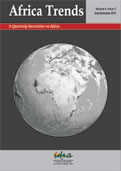Sanjay Badri-Maharaj
Publication
The Revival of the Air Force of Zimbabwe
The Air Force of Zimbabwe (AFZ) has an enviable combat record among the air forces of Sub-Saharan Africa. It has a strong professional ethos and, until budgetary cuts and sanctions came into effect, was one of the most effective air forces in the region. It has gone through a period of decline and relative stagnation in strength. However, the last two years point to a revival in its fortunes though this is through the restoring of grounded equipment to service.
- Published: January-December 2021
Nigeria’s Naval Power – Reviving capacity after prolonged decline
The Nigerian Navy is slowly clawing its way back to being a viable force capable of performing critical missions in respect of EEZ surveillance and patrol. It possesses an adequate fleet of inshore and riverine patrol craft and its growing refit and overhaul capabilities should prove adequate to the task of maintaining these vessels and augmenting them with new construction. However, the Nigerian Navy continues to face capability gaps in respect of the number of major surface combatants as well as the weapons systems available to the fleet.
- Published: July-December 2018
Trinidad and Tobago Coast Guard and the Australian Connection
The government needs to focus on meeting the Trinidad and Tobago Coast Guard’s urgent requirements for fuel so that their existing assets could be put to optimal use rather than squander funds on procuring an additional patrol boat from an Australian company.
- Published: June 08, 2018
Crippling the Trinidad and Tobago Defence Force
The Trinidad and Tobago Defence Force officer corps has a challenging task at hand to preserve the operational capability of the force as well as address the genuine concerns being expressed by their subordinates.
- Published: April 09, 2018
South Africa Boosts Naval Capabilities: But can it afford an expansion?
The RSA may be forced to choose between significantly increasing the budgetary allocations for the SAN and adopting a rotational storage programme to preserve capability while reducing operational costs.
- Published: February 05, 2018
India’s Relations with the Latin America-Caribbean Region: Prospects and Constraints
This paper seeks, from a Latin American perspective, to examine India's relations with the Latin America-Caribbean region. It makes a distinction between the hesitant and somewhat apathetic approach of the Indian government towards enhanced ties with the region and the rather more proactive and enthusiastic approach by the Indian business sector which has seen Indian trade with the region growing many fold and increasing at the same rate as China's.
- Published: 2017
The Response of CARICOM Armed Forces to Hurricane Maria
The deficiencies in planning and training of personnel for disaster relief operations as well as the capability gaps in equipment that the response to Huricane Maria highlighted need to be plugged.
- Published: December 06, 2017
The Indian Air Force’s Declining Squadron Strength – Options and Challenges
The IAF is not without options, all of which are currently at some stage of realization. What is lacking is a sense of urgency on the part of all the parties concerned.
- Published: November 03, 2017
Does India Need Thermonuclear Weapons
While thermonuclear weapons are not necessary for maintaining a credible deterrent, they serve the purpose of enabling India to make effective use of its relatively limited fissile material stockpile.
- Published: September 22, 2017












